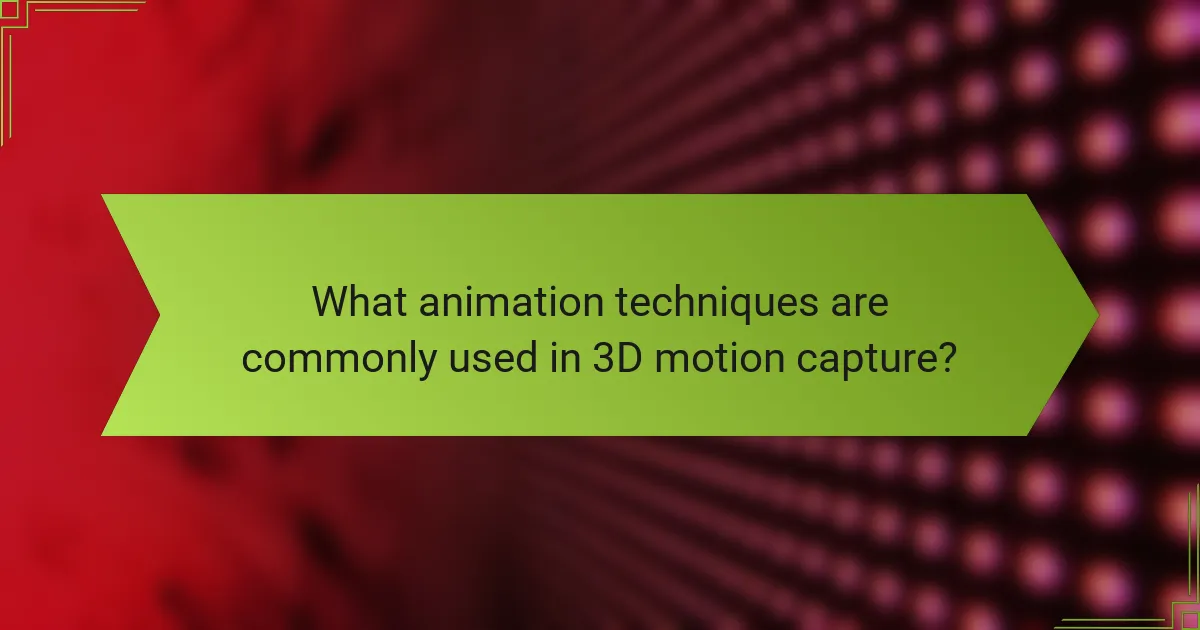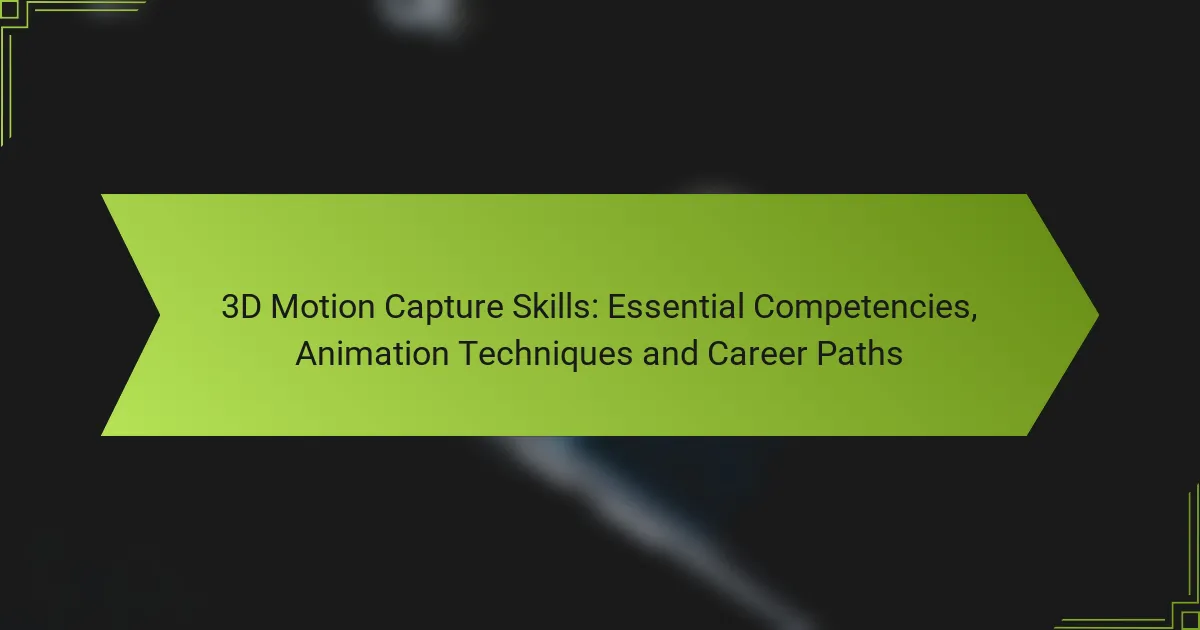3D motion capture is a dynamic field that combines technical skills with artistic creativity, requiring proficiency in specialized software and a deep understanding of biomechanics and animation principles. By mastering essential competencies, professionals can create lifelike animations that resonate with audiences across various industries, including gaming, film, and virtual reality. The techniques employed, such as keyframe animation and motion retargeting, play a crucial role in the animation pipeline, paving the way for diverse career opportunities.

What are the essential skills for 3D motion capture?
Essential skills for 3D motion capture include technical proficiency in specialized software, a solid understanding of biomechanics, knowledge of animation principles, strong problem-solving abilities, and effective collaboration and communication skills. Mastering these competencies enables professionals to create realistic and engaging animations that meet industry standards.
Technical proficiency in motion capture software
Being technically proficient in motion capture software is crucial for capturing and processing data accurately. Familiarity with programs like Autodesk MotionBuilder, Vicon Blade, or OptiTrack Motive allows animators to manipulate captured movements efficiently. Regular practice and staying updated with software updates can enhance your workflow and output quality.
Consider investing time in tutorials or online courses to deepen your understanding of these tools. Many platforms offer resources that can help you learn advanced techniques and shortcuts, which can significantly improve your productivity.
Understanding of biomechanics
A strong grasp of biomechanics is vital for creating realistic motion in animations. This knowledge helps animators understand how muscles, joints, and body mechanics interact during movement. Familiarity with concepts like center of mass and joint angles can lead to more lifelike character animations.
Studying human anatomy and movement patterns can provide insights into how to replicate natural motions. Resources like textbooks or online courses in kinesiology can be beneficial for building this foundational knowledge.
Animation principles knowledge
Knowledge of animation principles, such as timing, spacing, and exaggeration, is essential for effective motion capture. These principles guide animators in creating fluid and engaging movements that resonate with audiences. Understanding how to apply these concepts can elevate the quality of your animations significantly.
Practicing classic animation techniques, like the “12 Principles of Animation,” can enhance your skills. Applying these principles to motion capture data ensures that the final output feels dynamic and compelling.
Problem-solving abilities
Strong problem-solving abilities are necessary for addressing challenges that arise during the motion capture process. Issues such as data noise, marker occlusion, or unexpected movement patterns can disrupt the workflow. Being able to troubleshoot these problems quickly is essential for maintaining project timelines.
Developing a systematic approach to identifying and resolving issues can be helpful. Keeping a checklist of common problems and their solutions can streamline your troubleshooting process and save time during production.
Collaboration and communication skills
Collaboration and communication skills are essential for working effectively in a team environment. Motion capture often involves multiple stakeholders, including animators, directors, and technical staff. Clear communication ensures that everyone is aligned on project goals and expectations.
Practicing active listening and providing constructive feedback can foster a positive team dynamic. Regular meetings and updates can help keep all team members informed and engaged throughout the project lifecycle.

What animation techniques are commonly used in 3D motion capture?
3D motion capture utilizes several animation techniques to bring characters and scenes to life. Key methods include keyframe animation, blend shapes, motion retargeting, and real-time animation, each serving distinct purposes in the animation pipeline.
Keyframe animation
Keyframe animation involves setting specific points in time where an object’s position, rotation, or scale changes. These keyframes serve as anchors, allowing software to interpolate the motion between them. This technique is widely used for creating smooth transitions and dynamic movements in animated sequences.
When using keyframe animation, it’s essential to plan the timing and spacing of keyframes carefully. A common pitfall is overcrowding keyframes, which can lead to unnatural motion. Aim for a balance between keyframes and the fluidity of movement.
Blend shapes
Blend shapes are a technique used to create facial expressions and subtle deformations by blending multiple target shapes. This method is particularly effective for character animation, allowing for a range of emotions and reactions by adjusting the influence of each shape.
To implement blend shapes effectively, start with a neutral base shape and create variations for different expressions. Keep in mind that excessive blending can lead to unrealistic results, so it’s crucial to maintain a natural look by limiting the number of active shapes at any given time.
Motion retargeting
Motion retargeting allows animators to apply motion capture data from one character to another, even if the characters have different proportions or rigs. This technique is vital for reusing animations across various characters, saving time and resources in the animation process.
When retargeting, ensure that the source and target characters are compatible in terms of skeleton structure. Adjustments may be necessary to maintain the intended motion quality, especially for characters with significantly different body types.
Real-time animation
Real-time animation refers to the ability to animate characters and objects in real-time, often used in gaming and virtual reality applications. This technique relies on motion capture data being processed and rendered instantly, allowing for interactive experiences.
To achieve effective real-time animation, optimize the motion capture data to reduce latency. Consider using lower-resolution data for less critical animations to enhance performance without sacrificing quality. Regular testing in the target environment is essential to ensure smooth interactions and responsiveness.

What career paths are available in 3D motion capture?
3D motion capture offers various career paths that leverage skills in technology, animation, and visual storytelling. Professionals can find roles in industries such as gaming, film, and virtual reality, each requiring distinct competencies and creative approaches.
Motion capture technician
A motion capture technician is responsible for setting up and operating the equipment that records movement data. This role involves calibrating cameras, ensuring proper lighting, and troubleshooting technical issues during the capture process. Technicians must have a solid understanding of both hardware and software used in motion capture systems.
To excel, technicians should familiarize themselves with industry-standard tools like Vicon or OptiTrack. Attention to detail and problem-solving skills are crucial, as any errors in data capture can affect the final animation quality.
3D animator
3D animators use motion capture data to create lifelike animations for characters and objects. They refine the raw data, adding artistic elements to enhance the final product. This role requires proficiency in animation software such as Autodesk Maya or Blender.
Animators should focus on understanding the principles of animation and character movement. They often collaborate with directors and game designers to ensure the animations align with the overall vision, making communication skills essential.
Game developer
Game developers integrate motion capture data into interactive experiences, creating realistic character movements in video games. This role encompasses programming, design, and testing, requiring a blend of technical and creative skills. Familiarity with game engines like Unity or Unreal Engine is vital.
Developers should consider the performance impact of motion capture data on gameplay. They must balance realism with game mechanics, ensuring that animations enhance user experience without compromising performance.
Visual effects artist
Visual effects artists utilize motion capture data to create stunning visual elements in films and television. They blend live-action footage with digital effects, requiring a strong understanding of compositing and animation techniques. Software skills in Adobe After Effects or Nuke are often necessary.
Artists should pay attention to the integration of motion capture data with live-action elements, ensuring seamless transitions. Collaboration with directors and cinematographers is key to achieving the desired visual style and storytelling impact.

What software tools are essential for 3D motion capture?
Essential software tools for 3D motion capture include specialized applications that facilitate the capture, processing, and animation of motion data. These tools are crucial for animators and developers to create realistic movements in digital characters and environments.
Autodesk MotionBuilder
Autodesk MotionBuilder is a leading software for motion capture and animation. It allows users to edit and refine motion data, making it ideal for creating high-quality animations. Its real-time capabilities enable animators to visualize changes instantly, which is essential for iterative workflows.
When using MotionBuilder, focus on mastering its character rigging and retargeting features. These tools help in adapting motion data from one character model to another, saving time and enhancing productivity.
Vicon Blade
Vicon Blade is a powerful motion capture software designed for high-precision tracking and analysis. It is widely used in film, gaming, and sports industries for its ability to handle large amounts of data efficiently. Blade provides tools for real-time feedback, which is critical for capturing accurate performances.
Consider utilizing Vicon Blade’s automated calibration features to streamline setup time. This can significantly reduce the time spent on preparing for motion capture sessions, allowing for more focus on performance capture itself.
Adobe After Effects
Adobe After Effects is a versatile tool for post-production that can enhance motion capture data through visual effects and compositing. While not a dedicated motion capture software, it is invaluable for integrating captured motion into broader animation projects. Its robust layering and effects capabilities allow for creative enhancements to motion data.
When working with After Effects, leverage its integration with other Adobe products for a smoother workflow. This can help in creating polished final outputs that combine motion capture with visual storytelling elements.
Unity
Unity is a leading game development platform that supports 3D motion capture integration for real-time applications. It allows developers to implement motion data directly into interactive environments, making it essential for game design and virtual reality projects. Unity’s asset store also provides additional tools and plugins to enhance motion capture workflows.
To maximize Unity’s potential, familiarize yourself with its animation system and how it interacts with motion capture data. This understanding can help in creating more immersive experiences and optimizing performance in real-time applications.

How to choose the right training program for 3D motion capture?
Choosing the right training program for 3D motion capture involves evaluating factors such as accreditation, industry connections, and hands-on opportunities. A well-structured program will provide both theoretical knowledge and practical skills essential for a successful career in this field.
Accreditation of the program
Accreditation ensures that a training program meets specific educational standards and is recognized by industry professionals. Look for programs accredited by reputable organizations, as this can enhance your resume and job prospects.
Research the accreditation status of the institution offering the program. Programs affiliated with established universities or industry bodies often provide a more credible education, which can be beneficial when applying for jobs in 3D motion capture.
Industry connections and internships
Programs with strong industry connections can facilitate valuable networking opportunities and internships, which are crucial for gaining real-world experience. Consider programs that have partnerships with animation studios, gaming companies, or film production houses.
Internships can significantly enhance your skills and employability. Look for training programs that include internship placements as part of their curriculum, allowing you to apply what you’ve learned in a professional setting and build a portfolio that showcases your capabilities.
